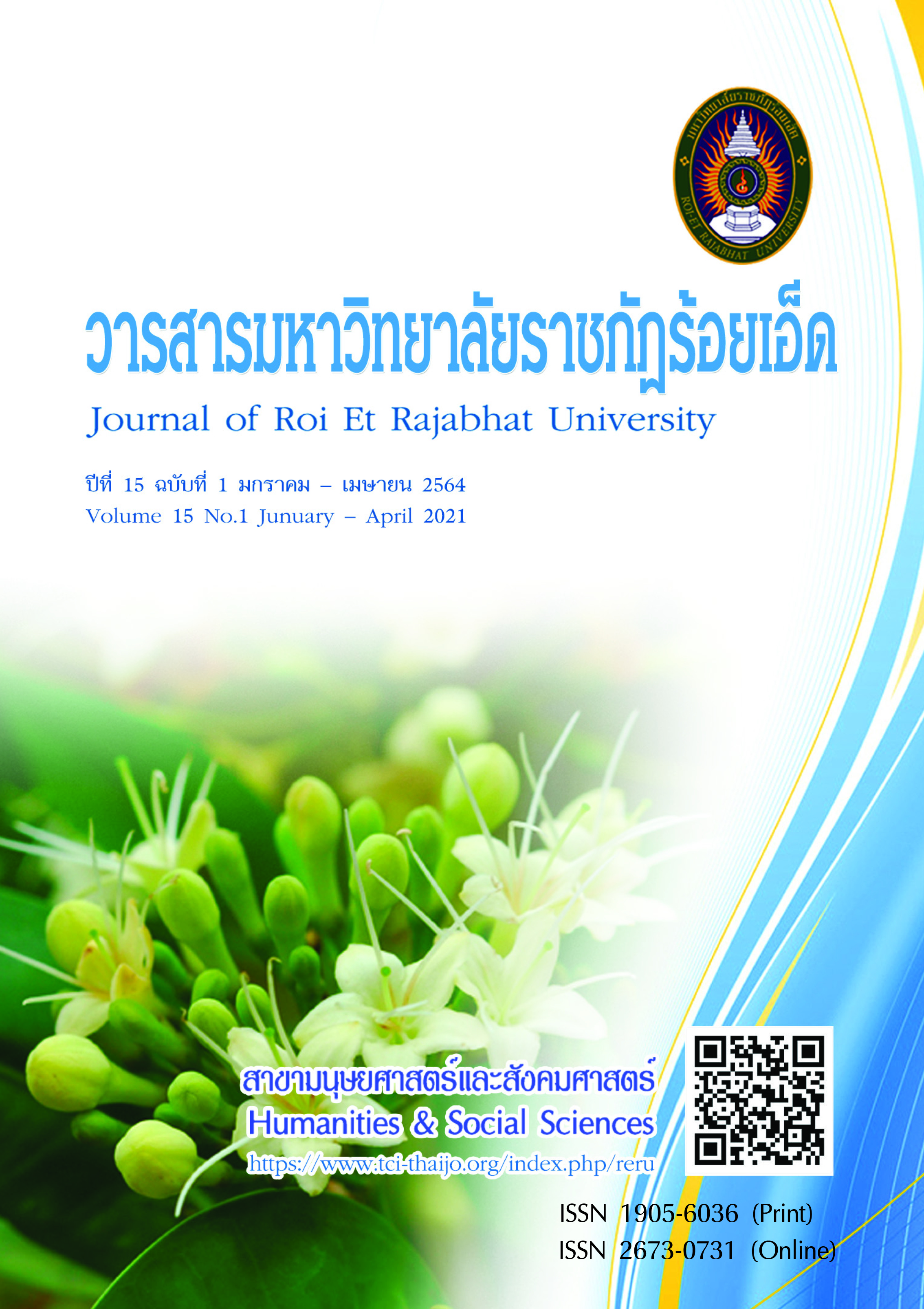Development of Mathematics Learning Activities Using KWDL Technique to Promote Mathematical Problem Solving Abilities and Learning Achievement on Percentage Problem Topic of Grade 6 Students
Keywords:
KWDL Technique on Mathematics learning activity, Mathematics learning achievement, Mathematical problem solving abilitiesAbstract
The objectives of this study were 1) to develop mathematics learning activities using the KWDL technique for percentage problem topic with the efficiency of 75/75, 2) to find out the effectiveness index of the lesson plans based on learning activities through the KWDL technique, 3) to compare the learning achievements between students who learned based on KWDL technique and traditional approach, and 4) to compare mathematical problem solving abilities of students between the two groups. The samples were 35 students in class 6/1 and 35 students in class 6/4 from Watsratong Municipal School, Roi Et Province. The samples were selected through cluster random sampling. The research instruments included KWDL lesson plans, traditional approach lesson plans, a learning achievement test, and a mathematical problem solving ability test. Statistics for data analysis were percentage, mean, S.D., and t-test (Independent Samples). The results were as follows: 1) The efficiencies of learning activities; based on the KWDL technique was 80.78/80.14 and the traditional approach was 78.98/75.71. 2) The effectiveness index of the KWDL lesson plans was 0.5638 whereas the traditional lesson plans was 0.5014. 3) The students who learned based on KWDL lesson plans had higher post-learning achievements than their counterparts at .05 level of significance (p<.05). 4) The students attending the KWDL classroom had higher post-mathematical problem solving abilities than their counterparts at .05 level of significance (p<.05).
References
น้อมศรี เคท. (2536). การสอนการแก้โจทย์ปัญหาคณิตศาสตร์ในหลักและแนวปฏิบัติในโรงเรียนประถมศึกษา. กรุงเทพฯ: ไทยวัฒนาพาณิช.
วราภรณ์ กิจสวัสดิ์. (2553). การพัฒนาผลการเรียนรู้และความสามารถในการแก้โจทย์ปัญหาเศษส่วนของนักเรียนชั้นประถมศึกษาปีที่ 6 ด้วยการจัดการเรียนรู้โดยใช้เทคนิค KWDL. กรุงเทพฯ: โรงเรียนอัสสัมชัญแผนกประถม.
สุลัดดา ลอยฟ้า. (2536). เอกสารประกอบการสอนวิชารูปแบบการสอน. ขอนแก่น: มหาวิทยาลัยขอนแก่น.
กระทรวงศึกษาธิการ. (2551). หลักสูตรแกนกลางการศึกษาขั้นพื้นฐาน พุทธศักราช 2551. กรุงเทพฯ: โรงพิมพ์ชุมนุมสหกรณ์การเกษตรแห่งประเทศไทย.
สถาบันทดสอบการศึกษาแห่งชาติ. (2560). รายงานผลการทดสอบทางการศึกษาระดับชาติขั้นพื้นฐาน (O-NET) ชั้นประถมศึกษาปีที่ 6 ปีการศึกษา 2557-2560. สืบค้นเมื่อ 24 มีนาคม 2562, จาก http://www.niets.or.th
สมนึก ภัททิยธนี. (2546). การวัดผลการศึกษา (พิมพ์ครั้งที่ 4). กาฬสินธุ์: ประสานการพิมพ์.
ชญาณิศา เป็งจันทร์, นพพร ธนะชัยขันธ์ และสุดาพร ปัญญาพฤกษ์. (2557). การจัดการเรียนรู้โดยใช้เทคนิค KWDL เพื่อพัฒนาผลสัมฤทธิ์ทางการเรียนคณิตศาสตร์ เรื่อง โจทย์ปัญหาของนักเรียนชั้นประถมศึกษาปีที่ 6. Journal of Graduate Research, 8(1), 71–82.
นิรันดร์ แสงกุหลาบ. (2547). การเปรียบเทียบผลการเรียนรู้เรื่องโจทย์ปัญหาทศนิยมและร้อยละของนักเรียนชั้นประถมศึกษาปีที่ 5 ที่จัดการเรียนรู้ด้วยเทคนิค เค ดับเบิ้ลยู ดี แอล และตามแนว สสวท. นครปฐม: มหาวิทยาลัยศิลปากร.
สุคนธ์ สินธพานนท์. (2552). นวัตกรรมการเรียนการสอนเพื่อพัฒนาคุณภาพของเยาวชน (พิมพ์ครั้งที่ 3). กรุงเทพฯ: 9119 เทคนิคพริ้นติ้ง.
บุญชม ศรีสะอาด. (2545). การวิจัยเบื้องต้น (พิมพ์ครั้งที่ 7). กรุงเทพฯ: สุวีริยาสาส์น.
วิมลรัตน์ ศรีสุข. (2551). การพัฒนากระบวนการเรียนการสอนโดยการบูรณาการรูปแบบการสร้างมโนทัศน์กับรูปแบบการแปลงเพื่อสร้างความรู้ทางคณิตศาสตร์ และความสามารถทางการคิดแบบอุปนัยของนักเรียนมัธยมศึกษาตอนต้น. จุฬาลงกรณ์มหาวิทยาลัย. ดุษฎีนิพนธ์ ครุศาสตรดุษฎีบัณฑิต สาขาวิชาหลักสูตรและการสอน. กรุงเทพฯ: จุฬาลงกรณ์มหาวิทยาลัย.
ภัทรา สุวรรณบัตร. (2552). วิธีการเรียนรู้สู่ความสำเร็จในการเรียนคณิตศาสตร์. วารสารวิชาการ (สำนักงานคณะกรรมการการศึกษาขั้นพื้นฐาน), 12(2), 66.
รัตนา ตั้งศิริชัยพงษ์. (2553). รูปแบบการสอนวิชาคณิตศาสตร์เพิ่มเติมที่ประยุกต์ใช้กลยุทธ์การพัฒนาตนเองด้วยสัญญาการเรียนในการพัฒนาสัมฤทธิ์ผลทางการเรียนคณิตศาสตร์ ของนักเรียนด้อยสัมฤทธิ์ชั้นมัธยมศึกษาปีที่ 5 โรงเรียนท่าบ่อ จังหวัดหนองคาย. วารสารวิชาการ (สำนักงานคณะกรรมการการศึกษาขั้นพื้นฐาน), 14(4), 6.
Hunter, J.E. and Schmidt, F.L. (1990). Methods of meta-analysis. Newbury Park: Sage.
Othman, N. (1997). The effects of cooperative learning and traditional mathematics instruction in grades K-12: a meta-analysis of findings. Dissertation Abstract International, 12(57), 50.
Shaw, J.M., Chambless, M.S., Chessin, D.A., Price, V. and Beardain, G. (1997). Cooperative problem solving: using K-W-D-L as an organizational technique. Retrieved December 10, 2017, From https://eric.ed.gov/?id=EJ545198
Williams, W. (1971). Social policy research and analysis: the experience in the federal social agencies. New York: American Elsevier.
Downloads
Published
How to Cite
Issue
Section
License
บทความที่ได้รับการตีพิมพ์เป็นลิขสิทธิ์ของวารสารมหาวิทยาลัยราชภัฎร้อยเอ็ด
ข้อความที่ปรากฏในบทความแต่ละเรื่องในวารสารวิชาการเล่มนี้เป็นความคิดเห็นส่วนตัวของผู้เขียนแต่ละท่านไม่เกี่ยวข้องกับมหาวิทยาลัยราชภัฎร้อยเอ็ด และคณาจารย์ท่านอื่นๆในมหาวิทยาลัยฯ แต่อย่างใด ความรับผิดชอบองค์ประกอบทั้งหมดของบทความแต่ละเรื่องเป็นของผู้เขียนแต่ละท่าน หากมีความผิดพลาดใดๆ ผู้เขียนแต่ละท่านจะรับผิดชอบบทความของตนเองแต่ผู้เดียว





